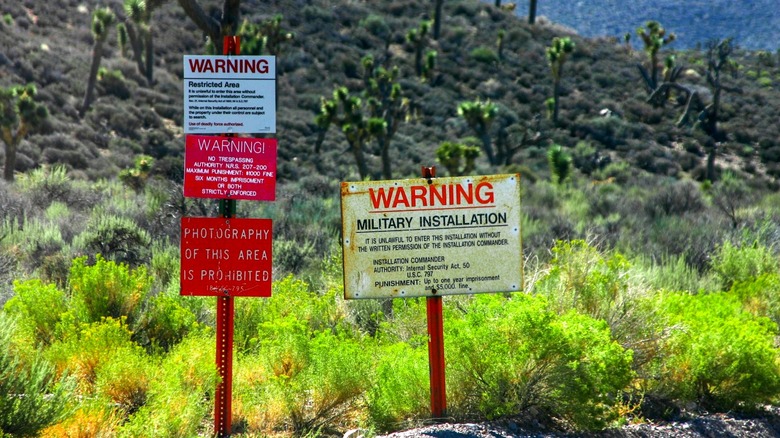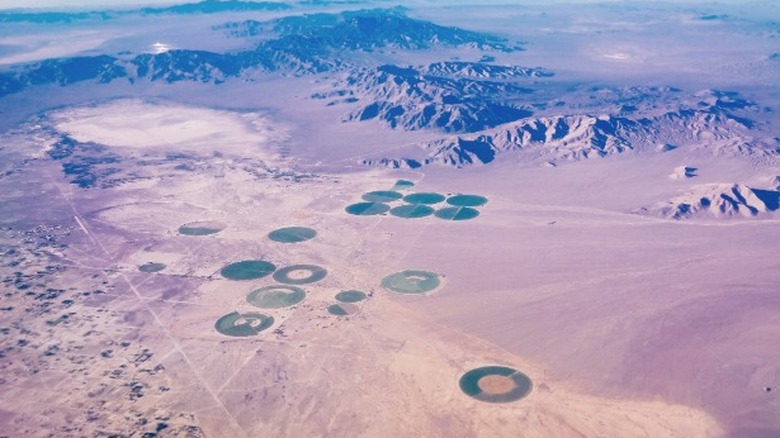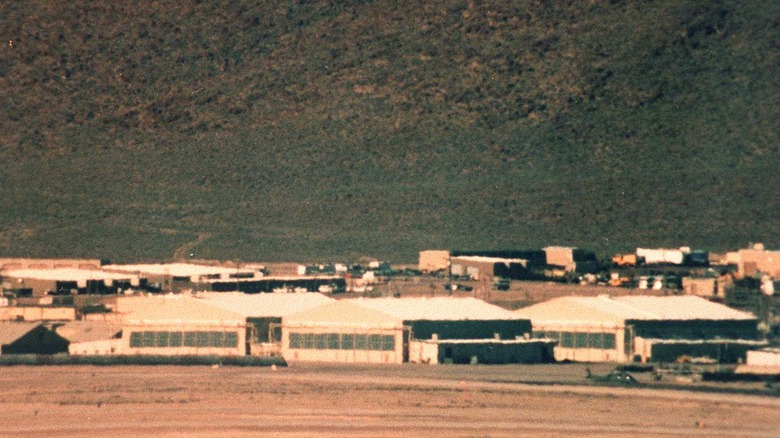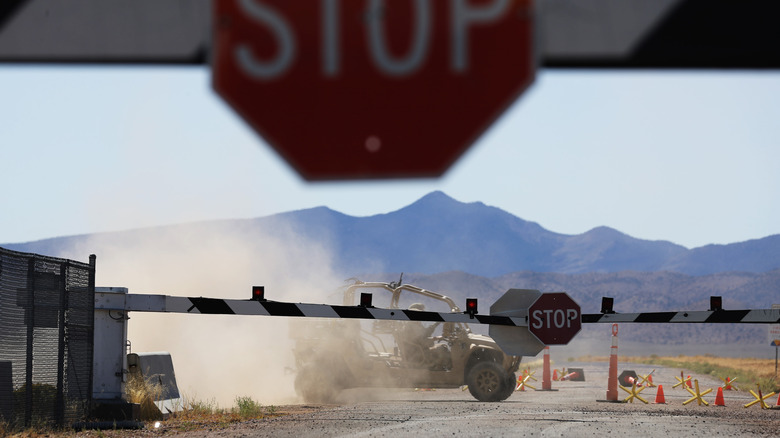How Hard Would It Be To Break Into Area 51?
Deep within a remote patch of desert in Southwestern Nevada, down a rough dirt road, a wall of unfriendly fence (wrapped with shock wire) demarcates the perimeter of Area 51. Somewhere deep within that perimeter lies the legendary subterranean top-secret base, forever off-limits to all but a flock of surveillance cameras. Affixed to the fence's barbed wire are retroreflective signs emblazoned with big bold letters bearing a proverb as ancient as government itself: "Keep Out." Helicopters, aerial watchtowers, drones, clandestine sensor system alerts, networks of security cameras, and heavily-armed guards authorized to use deadly force patrol the site's 90,000-acre perimeter 24 hours a day (via Vox).
The top-secret facility is situated within the Nevada Test and Training Range, a military-controlled distract roughly the size of Connecticut. But how hard would it really be to break in to Area 51? In the words of international security scholar James Forest (via Wired), it would be "completely suicidal" to even try.
Area 51 Will Know You're Coming Before You Arrive
The facility's 90,000 acres — and much of the land surrounding it, including public areas — are equipped with a complex system of above-and-below-ground motion sensors. Older models of these sensors were discovered by Nevada resident Chuck Clark in 1999. "They're very, very hard to find, because there's just this little wire, like a blade of grass," Joerg Arnu, who found similar devices nearby in the early 2000s, told Security Focus.
Even Area 51's security protocols are top-secret — which means it's almost definitely not the fence you should be worried about. In "Area 51: An Uncensored History of America's Top Secret Military Base," T.D. Jacobson confirms our most paranoid suspicions: "Having been in the business, I would expect we have surveillance capability being used that we won't know about for years."
The stark rarity of Area 51's remarkable geographic obscurity is a major security asset. It is a fortress deep within a dead desert expanse of featureless nothing — intentionally, of course. In the early 1950s, President Dwight D. Eisenhower ordered a team to identify the most remote, secret, and obscure location in the United States for the project that would become Area 51. They settled on a salt flat next to Groom Lake, Nevada, and it definitely fit the bill. The site where Area 51 is located it is virtually inaccessible by land. Employees commute to work by airplane or stay in complexes onsite (via Britannica, Vox).
You'd Have Better Luck As An Ex-Employee
In fact, for the first quarter-century of Area 51's existence, the top-secret knowledge that a base existed in Groom Lake, Nevada (or anywhere else) remained a secret. As far as you, me, or the Soviets were concerned, no project by that name existed. This all fell apart in 1989 when ex-Area 51 employee Bob Lazar (and ex-trespasser himself, as a matter of fact) broke his oath of secrecy on live television. That was the first time we heard the story (and now-infamous trope) of a remote military base with gray aliens (via Annie Jacobson, "Area 51: An Uncensored History of America's Top Secret Military Base"). He told Eyewitness News the base was called Area 51.
Lazar's legendary story of Area 51 took on a life of its own in the American imagination, sprouting a rich genre of paranormal mythology. The story took on a life of its own. Area 51 became a pit stop for shipwrecked extraterrestrials, a secret center for spies, and even a production studio utilized to fake the moon landing. There are even Area 51 apologists who believe that inside the gates of this top-secret facility dead Soviet dictator Joseph Stalin is hard at work genetically engineering alien clones with the help of a Nazi doctor (it's unclear where these self-attested experts may have obtained this information).
Attempts to Break In to Area 51 Are Rare
Area 51 was an early testing site for nuclear bombs and highly-advanced stealth surveillance technology in the Cold War, so the truly weird things that go on there have always been shrouded in secrecy. Steven Aftergood, director of the Project on Government Secrecy at the Federation of American Scientists, believes this secrecy is responsible for conjuring the aura of mystery and suspicion that has the American psyche hooked. "The U2 spy plane, the SR-71, the F-117A stealth fighter, all were flight-tested out of the Groom Lake facility," he explained (via Security Focus). "[The myth of Area 51] is a manifestation of official secrecy at its most intense, and that invites a mixture of paranoia and speculative fantasy that has become ingrained in popular culture."
It wasn't until 2013 when the CIA released a series of heavily-redacted declassified documents that the federal government admitted Area 51 was a real place. After 57 years, it shared its name with the American public. And that's pretty much all they've shared ever since. For the dozens of aforementioned reasons (including the complex surveillance systems and threat of deadly force), attempts to venture near the facility are not common.
'Automated Deadly Force Countermeasures Are In Place'
The few who have tried have not been lucky. The roughly 40 attendees of the now-legendary fake-then-almost-real event "Storm Area 51: They Can't Stop All of Us" who actually made the complete trek to Area 51's back gate in 2019 were stopped before ever approaching the fence. Six were arrested for various offenses including public urination and public intoxication (via News Channel 9), but none, in fact, succeeded in storming it. One individual who appeared to attempt to walk up to the gate (lit up by bright floodlights and overlooked by a formidable flock of surveillance cameras) wisely halted at a sharp warning from a guard. All guards at Area 51 are authorized to use deadly force. In 2019, a man was shot and killed by guards at Area 51 after barreling into the facility in his vehicle then allegedly emerging with a cylindrical object (via Las Vegas Review-Journal). Two Dutch Youtubers who ignored the "No Trespassing" signs were arrested that same year, according to the Washington Post.
According to Annie Jacobson, author of "Area 51: An Uncensored History of America's Top Secret Military Base," sometimes it's possible to catch a glimpse of the mysterious sanctum's slightest activity from Tikaboo Peak, a mountain 26 miles away, through binoculars. But only if you're lucky.




